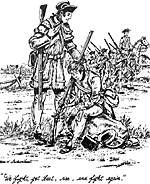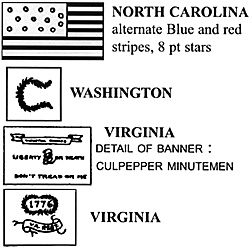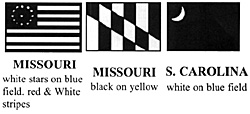Although uniforms and flag information is often sketchy at best, a reasonable picture of the Southern army can be created. Unit strengths, organization, and dates of service are more certain. It should be recalled that the Virginia, North Carolina and South Carolina regulars serving in the South were captured when Charleston surrendered in May 1780. In addition, most of the Maryland and Delaware regulars were decimated at the Camden in August of the same year. Therefore, Lefferts' "Uniforms of the Revolution" is of very little use for American uniforms in the South. Most useful, however, is Harold Peterson's "Book of the Continental Soldier" and numerous issues of The Military Collector and Historian". Greene's army thus consisted of a small core of regular light infantry and cavalry, which were often supplemented by militia. Militia infantry (not riflemen) should probably not be done in a 1:10 scale, but rather on a 1:25 or 30 scale with appropriate roster adjustments. This saves money and avoids an odious chore of painting hordes of troops who served only periodically and often with little effect. The partisans of Marion, Sumter, Pickens and others can be drafted from militia figures when needed. My descriptions and suggestions are tailored for wargames and of course, can be revised to suit personal tastes or additional information.
Lt. Col. William Washington's Dragoons consisted of the remnants of the 1st (Lt. Col. White absent) and 3rd (Washington) Continental Light Dragoons (not the 4th also; they never fought in the south before Yorktown, contrary to popular belief). Washington's command of about 100 men fought in four combat troops with a small HQ unit, serving throughout the period. Since the 3rd had been rebuilt twice and the 1st once prior to Greene's tenure, it is unlikely that any men wore uniforms issued prior to 1780 (white for the 3rd and blue or brown for the 1st). According to the 1779 regulations that were in effect in 1781, the cavalry was supposed to wear blue coats faced and lined white. This uniform may have been worn by some of the officers, but most of the dragoons probably wore hunting shirts or occasional blue-black jackets with a variety of buff or white breeches and black boots. The cavalry commonly wore black leather jockey style helmets with red-brown or white horsehair crests. The unit was equipped with a variety of accouterments (see Peterson) and carried a small 2' x 2' red damask battle flag embroidered with a red silk horseshoe (see illustration).
Delaware Infantry was represented by two small companies, one commanded by Peter Jacquett and placed in the 1st Maryland; and one led by Capt. Robert Kirkwood as an independent light infantry unit (often with Washington's horse). Kirkwood's company was the larger of the two, usually mustering slightly over 1 00men. The regulation uniform consisted of blue coats faced red and lined white (identical to that order for the Virginia and Maryland regulars), but only Jacquett's company may have worm them and only when the 1st Maryland received any. Kirkwood's men wore hunting shirts. All wore black tricorns (and a few caps possibly) bound with yellow tape, and they carried a variety of accouterments and muskets.
Maryland Infantry served in two small battalions or regiments (variously called the 1st Md. and 2nd or 5th Md.) of about 300 men each average. Each battalion had four to nine companies and a small HQ. Col. John Howard and Lt. Col. John Gunby commanded the 1st, while Lt. Col. Benjamin Ford and Major Henry Hardman led the 2nd. Both units served throughout the period and were the survivors of the Camden disaster (see Delaware's). In addition to the regulation uniform (see Delaware's), white overalls and smallclothes were common. They usually wore black tricorns trimmed with white tape. Musicians wore reversed coat colors and officers were distinguished by silver epaulettes. But clothing shortages often forced the man to wear an assortment of hunting garb and civilian clothing. In a war game, one unit might be painted in regulation uniforms and the other in hunting shirts. They were accoutered like the Delaware's. Two flags are commonly associated with Maryland regiments. One flag definitely carried in the South resembles the Stars and Stripes and measured 3' x 5' (see illustrations). Another flag is one of the black and yellow checkered quarter of the Maryland State flag. Some type of standard similar to the Virginia regiments may have also been carried.
Virginia Infantry also served in two small battalions or regiments (variously called the 1st or 4th and 2nd or 5th) of about 300 men each in four to nine companies per unit. Colonel John Greene commanded the first unit, built around the survivors of Buford's regiment (decimated at Waxhaws in May 1780) and Lt. Col. Richard Campbell served throughout the period. The second unit led by Lt. Col. Samuel Hawes and Major Smith Snead arrived in February 1781. These men ware to be dressed like the Maryland and Delaware troops by regulation. The latter unit was probably the better dressed, while the other being reduced to wearing hunting garb and civilian clothing. In a war game, one unit might wear regimentals, and the other should wear hunting garb or probably brown coats faced with red or green (old regimentals or militia uniforms). Any colors may have resembled the solid red standard with yellow scroll trimmed and lettered with rgt. number in gold drawn in the illustration (with or without the "1776").
Maryland-Delaware Light Battalion of November 1780 to February 1781 was a temporary unit of 300 men in three companies drawn from the Maryland Delaware, and Virginia units. Usually commanded by John Howard.
A company under Captain Stagleton represented the 1st Continental Artillery. It averaged four to six light field pieces (three to nine pounders) and 40-60 artillerymen. Their uniform was blue, faced and lined red. Buff or white smallclothes, and a black tricorn bound with yellow tape. Gun tubes were black and carriages appeared in a variety of browns and also blue like the French.
Staff usually wore personal uniforms, but were supposed to wear blue regimentals faced and lined buff, or buff or white small clothes, and yellow metal along with the tricorns.
NOTE: For belting, weapons and accouterments of all troops, consult Peterson and the other works cited in the bibliography.
Cavalry from most of the southern states served periodically as mounted infantry or light horse, usually in small 40 to 50 man troops. Most probably wore hunting shirts. McCall's Georgians and Marion's and Hampton's South Carolina were a significant number.
Riflemen who fought with the deadly long rifle can be considered an elite class of militia. They usually formed into 200 man units and came from the backcountry of Virginia and the Carolinas. Their famous uniform of hunting frocks of various colors is well illustrated.
Infantry from Georgia, Virginia, and the Carolinas served periodically throughout the campaigns in 400-600 man brigades. I recommend setting up a "militia infantry pool" revolving around a few command stands from the states involved. Since the men wore no uniform other than hunting or civilian clothing is most cases, this approach avoids recreating every militia unit that served. Except for the blue and red striped with blue stars on a white field North Carolina militia flag, flags are uncertain. I have added a Virginia (Culpepper Minutemen — white field, black devices) and a South Carolina (blue field with white moon) flag which might be used for militia. It is best to apply your imagination to the uniforms and other characteristics of militia.
Using a 1:10 scale as a general model, a rough standardized war game army can be organized as I have illustrated. Musicians for the cavalry are optional. The Militia brigade can be assigned various figure to man ratios on a roster.
KEY: X=line, *=officer +=musician, @=flag bearer, and !=artillery
Regular Infantry Unit:
Light Infantry Unit:
Lee's Cavalry:
Washington's Cavalry:
Artillery stand:
Militia Brigade (2 Btns.)
NOTE: All infantry and artillery crews should be mounted on a 1" x 1 1/2" stand, while cavalry, guns and mounted staff should be mounted one per stand (Same size as company stands above). A collection can be started by acquiring the light troops first and adding regulars and militia later. This still allows for some action while painting and collecting. Do the same for the British.
Berg, Fred A. Encyclopedia of Continental Army Units
 General Greene's southern campaigns of 1781 in the Carolinas present some of the most interesting and economical potential for war game set ups of the American Revolution. Because the opposing armies were relatively small at most times, their units can often be recreated on a 1:10 ratio or better. This fact, in addition to the emphasis on cavalry and light troops makes a period attractive as a primary or secondary collection. This article deals with Greene's forces for the period of December 1780 to September 1781. The British forces under Cornwallis and Rawdon will be covered in the future.
General Greene's southern campaigns of 1781 in the Carolinas present some of the most interesting and economical potential for war game set ups of the American Revolution. Because the opposing armies were relatively small at most times, their units can often be recreated on a 1:10 ratio or better. This fact, in addition to the emphasis on cavalry and light troops makes a period attractive as a primary or secondary collection. This article deals with Greene's forces for the period of December 1780 to September 1781. The British forces under Cornwallis and Rawdon will be covered in the future.
REGULARS
 Lt. Col. Henry Lee's Legion consisted of about 100 dragoons and 100 to 150 light infantry, each arm being divided into three troops or companies and a small HQ unit. The legion fought as both regulars and partisans throughout the period under study. Their uniforms included short green coats faced white or buff, lambskin breeches for the cavalry and white overalls for the infantry, horse hair crested (and sometimes plumed) brass helmets for the cavalry and probably black leather caps for the infantry. The legion wore a variety of accouterments, and the officers' metal was silver. The unit had a small blue flag sprinkled with white stars (probably 13 in no certain order).
Lt. Col. Henry Lee's Legion consisted of about 100 dragoons and 100 to 150 light infantry, each arm being divided into three troops or companies and a small HQ unit. The legion fought as both regulars and partisans throughout the period under study. Their uniforms included short green coats faced white or buff, lambskin breeches for the cavalry and white overalls for the infantry, horse hair crested (and sometimes plumed) brass helmets for the cavalry and probably black leather caps for the infantry. The legion wore a variety of accouterments, and the officers' metal was silver. The unit had a small blue flag sprinkled with white stars (probably 13 in no certain order).
 North Carolina Infantry consisted of two small 200-man battalions under Col. Jethro Sumner. They joined the army in August 1781 50 might be drafted from the militia. Regulations called for blue coats faced light blue and lined white (drummers wore blue faced white), but only the officers probably wore it. Hunting garb and civilian clothes were no doubt the order of the day, in addition to a variety of accouterments. Any colors might have resembled the Virginia flags, only with a light blue field.
North Carolina Infantry consisted of two small 200-man battalions under Col. Jethro Sumner. They joined the army in August 1781 50 might be drafted from the militia. Regulations called for blue coats faced light blue and lined white (drummers wore blue faced white), but only the officers probably wore it. Hunting garb and civilian clothes were no doubt the order of the day, in addition to a variety of accouterments. Any colors might have resembled the Virginia flags, only with a light blue field.
MILITIA
PROPOSED WAR GAME ORGANIZATION
XXX XXX *1+ XXX XXX
XXX XXX XXX XXX XXX
XX XX XX X* XX XX XX
XXX XXX *@+ XXX
XXX XXX *@+ XXX XXX
X!X
X
XXX XXX XXX * XXX XXX XXX
XXX *@ XXX XXX *@ XXX
SELECTED BIBLIOGRAPHY
Boatner, M. Encyclopedia of the American Revolution
Greene, N. Greene Papers (Library of Congress, Microfilm)
Kemp, A American Soldiers of the Revolution
Military Collector and Historian Various issues
Ogden, H. Numerous Color Plates
Peterson, H. Book of the Continental Soldier
Roundshot and Rammers
Risley, C. Numerous Prints and Plates
Ward, C. The War of the Revolution, II
Back to Table of Contents -- Courier #79
To Courier List of Issues
To MagWeb Master Magazine List
© Copyright 2000 by The Courier Publishing Company.
This article appears in MagWeb (Magazine Web) on the Internet World Wide Web.
Other military history articles and gaming articles are available at http://www.magweb.com